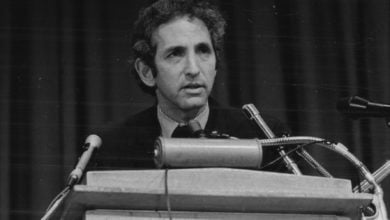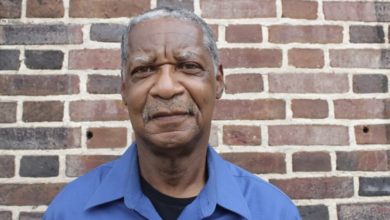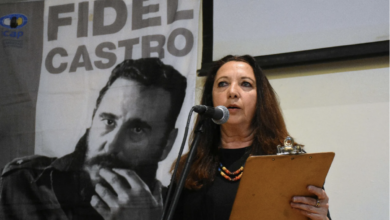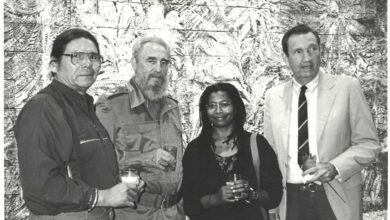
In January 1946, over 140 Indonesian nationalist and workers’ organizations came together to form the Struggle Front (Persatuan Perjuangan). The goal was to fight for complete independence from Dutch colonialism.
The formation of the Struggle Front was in many ways the crowning achievement in the life of Indonesian revolutionary Tan Malaka. Thanks to political persecution by a number of imperialist governments, forcing him to work underground and in exile for much of his political life, Tan Malaka’s role in the world working-class movement is not well known. Even in Indonesia, his place in the independence struggle is marked only by a small street sign in Padang. His three-volume autobiography, “From Jail to Jail,” was only translated into English in 1991 and received little attention in the English-speaking working-class movement.
When Tan Malaka was born—conflicting records claim either in 1896 or 1897—Indonesia did not exist as a separate country. Known as the Dutch East Indies, the island archipelago was really a system of plantations under the rule of the Netherlands.
The Dutch first colonized the East Indies in 1602. However, for the first nearly three centuries the islands were really integrated not as a colony in the sense that the other European powers had made infamous. Rather, they were administered by the Dutch East India Corporation as an economic unit.
Under the Dutch East India Corporation, a monoculture system of agriculture was imposed on individual islands. The Banda islands produced mace and nutmeg, for example, while Java produced tobacco and teak. In all cases, local agriculture was suppressed in the interests of cash crops for export.
By the 1890s, the primary employment for the native masses in the East Indies was as contract laborers on the plantations—known by the racist label “coolies.” “The natural wealth of Deli [in Sumatra] gave rise to [a] most wealthy, cruel, arrogant and conservative colonizing capitalist class as well as that most oppressed, exploited and humiliated class, the Indonesian contract coolie,” Tan Malaka wrote.
A former plantation boss described the conditions of the contract workers: “They are doing forced labor, or if you like they are slaves. The coolie slogs from morning till night, toiling and stooping; he has to stand up to the neck in stinking marshland, while greedy leeches suck his thin blood and malaria mosquitoes poison his sickly body. But he cannot run away, for the contract binds him.
“The tjententgs, the watchmen and constables of the firm, who have the strength of giants and are bestially cruel, track down the fugitive. When they catch him they give him a terrible hiding and lock him up, for the contract binds him.”
Combined with the brutal exploitation that formed the basis for the riches of the Dutch empire, Indonesians were subject to the day-to-day racism of colonial rule. “The conflict between the white, stupid, arrogant, cruel colonizers and the colored nation of driven, cheated, oppressed and exploited slaves—a conflict which found a few Indonesians as skilled labor caught in the middle—fouled the atmosphere … and gave rise to constant attacks by the coolies on the plantation Dutch,” Tan Malaka described in his autobiography.
The young Tan Malaka was relatively fortunate in that he was born to a prominent local family. A good student, he was sent to study in the Netherlands in 1913, where he trained to be a teacher. This was somewhat remarkable, since just 14 years earlier there were only 13 Indonesian high school students in all of the Dutch East Indies.
In Europe, he was exposed to the prevailing political currents of the time amid the dominating backdrop of European imperialist war and revolution in Russia. He worked with socialists and student organizations in his earliest political development.
Anti-colonial ferment
Tan Malaka arrived back in Indonesia in late 1919. It was a time of great political upsurge. For the first time, millions of Indonesians were organizing into anti-colonial organizations. Unions struck to improve conditions for the oppressed Indonesians.
“What the Dutch had called ‘the gentlest people on earth’ changed its character after suffering so much torment and cruelty, and, to take an analogy from the world around Deli, became ‘like a buffalo charging and trampling its enemies,’” Malaka described in his autobiography. “When I was there, between 100 and 200 Dutch people were killed or wounded in attacks by coolies every year.”
By far the largest organization of Indonesians was the Islamic Union (Sarekat Islam), which had been founded in 1911 to protect the interests of native batik merchants. By 1919, however, the Islamic Union had become a truly mass organization with over 2 million members, mostly among the poor peasantry. Historian Ruth McVey described the Union’s rural offices as effectively functioning as “complaint bureaus” for the native population against the colonial authorities.
One of the tasks that won the Islamic Union wide support was the unofficial “people’s schools” that it set up. Tan Malaka had originally taken a position teaching children of contract workers on a Dutch plantation in East Sumatra. That experience gave him first-hand experience with the racism and exploitation that characterized Dutch colonialism.
He gradually became involved in workers struggles, helping to organize a railway workers’ strike in 1920. In 1921, Malaka moved to Java and immersed himself with the task of organizing a “people’s school” in Semarang—what Malaka called “the Red City.” The school was set up under the auspices of the Islamic Union, and soon became the model for other schools around the country.
The growth of communism
Parallel to the growth of the Islamic Union was the emergence of the Indonesian Communist Party (PKI). The PKI had been formed in 1920, the first communist party in Asia outside Russia. It was based on the organizational work of Dutch socialists like Henry Sneevliet, a militant leader who had organized soldiers’ unions in Indonesia against World War I. But by 1920, the party had attracted Indonesian leaders who were able to speak to and organize Indonesian workers and peasants in their own language.
Tan Malaka, influenced by his experiences with Indonesian workers as well as by the 1917 Russian Revolution, immediately gravitated toward the PKI. The PKI chairman, Semaun, worked closely with this talented activist, recruiting him into the party and giving him significant leadership roles from the outset.
In addition to his role in organizing the “people’s schools,” Tan Malaka took a position on the executive council of the PKI-led Revolutionary Federation of Trade Unions (RVC). By 1921, Malaka was elected chairman of the PKI after Semaun left the country. The 25-year old leader immediately put his stamp on the party.
He based his program on bold mass action—a position he felt that his predecessors had been too cautious with. “Certainly we need to have a program in the Indies,” he told the December 1921 PKI Congress, “but that program must be very brief. The program must not have chapters or paragraphs: it must contain only one word, and that is action. Action by the Indies proletariat for a clear and consistent goal, the withdrawal of the powers which so greatly impede and injure the popular movement.”
Another characteristic of his leadership was his struggle for unity with the Islamic Union. The party’s whole influence had until that time been won by working within the Union, viewing it as a mass organization with a heavily working class and peasant composition. However, as a primarily nationalist organization, the leadership of the Islamic Union was wary of communist influence.
In the growing competition between communist-led branches of the Union and more conservative branches, different views arose within the PKI over what orientation to take toward the leadership of the Islamic Union. These differences reflected an international issue: what is the attitude of communists toward national liberation struggles not led by the working classes? It was a subject that had been discussed at the 1920 meeting of the Communist International in Moscow.
Tan Malaka was a proponent of struggling against a split with the Islamic Union. He repeatedly emphasized the joint interest that the organizations had against Dutch colonialism, despite secondary differences. Because of his arguments, the 1921 PKI congress resolved to petition the Communist International to review the issue of communist work with Islamic movements.
Tan Malaka’s program of action was put to the test within weeks.
Pawnbrokers—essentially at the time a kind of low-level civil service employees—launched a national strike in January 1922 against racist government orders and firings. Tan Malaka urged the party to support the strike vigorously, and organized with the RVC to launch sympathy strikes. In February, he was arrested by colonial police and exiled. His exile ended his only formal leadership role within the Indonesian communist movement.
Revolutionary in exile
He did continue to represent the PKI internationally. He attended the meetings of the Executive Committee of the Communist International in Moscow in November and December 1922, where he argued forcefully for recognizing the revolutionary potential of the pan-Islamic movements.
In late 1923, Malaka traveled to China representing the Comintern. There he met with communists from China and Indonesia as well as other political figures like Chinese nationalist Sun Yat-sen. He took responsibility for setting up a communist magazine—an extremely difficult task, since Malaka did not know Cantonese.
After pursuing his political work in Canton, he traveled to the Philippines in 1925—at that time a U.S. colony. Malaka met with many of the Philippine revolutionaries who would in 1930 set up the Philippine Communist Party—in fact, some credit him with having helped initiate the party.
As Tan Malaka was doing political work in exile, the situation in Indonesia was sharpening. In late 1925, the PKI began organizing for a revolutionary insurrection.
Malaka received word of these plans while in the Philippines and tried to intervene in the discussions. He considered the planned uprising to be premature and adventuristic. During this period he wrote “Mass Action,” an influential book arguing for the Indonesian national liberation struggle and socialist revolution to base itself on organizing the working masses.
Despite his efforts, the uprisings did take place in late 1926 and early 1927—and were crushed. Thousands of communists and their supporters were arrested and sent into exile. The anti-communist repression foreshadowed the massacre of over 1 million Indonesian communists in 1965.
Still in exile, Malaka traveled to Bangkok to meet with surviving PKI members Subakat, a leading theoretician, and Djamaluddin Tamim. Reviewing the experience of the party, the three formed the Republic of Indonesia Party (PARI) in June 1927. Its manifesto declares the party to be “proletarian-revolutionist.”
The attempt to regroup revolutionary elements of the PKI had little success. Tan Malaka was arrested again in the Philippines by U.S. colonial police in August 1927, days after returning. Subakat was arrested in exile in Bangkok in 1929 and died in prison in 1930, probably tortured. Tamim was arrested in 1932 in Singapore.
The PARI did maintain a clandestine presence in Indonesia at least through the mid-1930s. Dutch police records contain summaries of issues of the party’s newspaper Obor (the Torch). Australian scholar Helen Jarvis cites one of the police intelligence reports of the June 1935 issue as “typical hate-sowing writings one would expect from a PARI mentality” attacking “Dutch imperialism’s ruling methods in Indonesia.” (“Partai Republik Indonesia: Was it the ‘sole golden bridge to the Republic of Indonesia’?,” 1980)
After Tan Malaka’s arrest in the Philippines, a mass campaign in the Philippines developed in support of asylum for the Indonesian communist. Despite mass meetings by students and unions and a collection of donations from the Philippine senate, he was deported again.
For the next 15 years, Malaka lived a lonely and difficult life. He assumed false identities in exile in China, Hong Kong, Burma and Singapore. He constantly battled with poor health. He was constantly hunted by colonial police forces—U.S., British and Dutch.
Japanese occupation
In 1942, in the midst of World War II, Japanese imperialists invaded Indonesia, quickly driving out the Dutch colonial regime. Tan Malaka took the opportunity to make his way back to Indonesia.

The imperialist war opened up a series of new questions for the Indonesian national liberation movement. After the liquidation of the PKI in 1926 and 1927, leadership of the national movement fell to nationalist leaders like Sukarno and Muhammed Hatta. These leaders blended elements of Marxism with anti-colonial nationalism, but did not favor class struggle as the means to achieve independence.
Japanese imperialism was able to employ elements of nationalism in its war against its European rivals. It promoted the ideal of the Greater East Asia Co-prosperity Sphere, an alliance of Asian nations against Western domination—with Japan at the center. It promoted slogans of “Nippon [Japan] and Indonesia are equals,” even promising self-rule within the context of the Co-prosperity Sphere.
Sukarno and Hatta followed a strategy of working within the Japanese war administration with the hopes of achieving independence afterwards. Sukarno formed the Putera organization, designed to mobilize Indonesian society for the war effort. This and later similar organizations did result in organized Indonesian militias for the first time in history. But they also legitimized the forced-labor camps involving hundreds of thousands of laborers.
Tan Malaka was closest to this latter group. On returning to Indonesia, he worked under a false name as an administrator of a coalmine. He witnessed first-hand the brutal treatment of the forced laborers. He organized the forced laborers into a number of groups to lessen the terrible working conditions.
Based on this experience and his consistent political perspective, Tan Malaka advocated a strategy of fighting for “100 percent independence” based on the strength of the mass struggle. He criticized Sukarno’s collaboration with the Japanese forces as weakening the potential strength of the working class.
By mid-1945, Japanese imperialism was clearly headed for defeat in the war. Japanese military authorities speeded up preparations for an independent Indonesia as a final political blow at the soon-to-be-victorious British and U.S. imperialists. On Aug. 17, 1945, Sukarno and Hatta proclaimed Indonesia’s independence.

Negotiations vs. struggle
With the defeat of Japan, however, Australian and British troops landed across the archipelago in order to oversee the surrender of Japanese troops—and to turn the newly independent nation back over to Dutch colonialism. The biggest obstacle they faced, though, was not the Japanese but the Indonesian pemuda—youth militants.
In October 1945, British demands for the disarmament of Indonesian troops and pemuda led to an outpouring of anti-colonial violence. On Oct. 28, 20,000 Indonesian troops and 120,000 pemuda launched an attack on 6,000 British troops in Surabaya. The British would have been completely exterminated except for the fact that the British flew Sukarno and Hatta to the scene to calm the Indonesian militants.
It became increasingly clear that the former colonialists would now face a mobilized Indonesian country ready to fight for independence.
Again, though, two strategies emerged. Sukarno, Hatta and Sjahrir—who unlike Sukarno and Hatta had placed his hopes on a British and Allied victory in World War II—favored negotiations with the Dutch for a gradual transfer of power to the independent Indonesia.
But the masses were in motion. Tan Malaka, for the first time in decades operating openly in his own name, began to establish contacts with the most militant pemuda groups and other political forces.
That set the stage for the Jan. 4 and Jan. 5, 1946, founding conference of the Struggle Front (PP). By the second meeting on Jan. 15, 141 organizations were represented in the Front—including significant sectors of the republican army.
The PP adopted a seven-point program: negotiations on the basis of recognition of 100 percent independence, a people’s government, a people’s army, disarmament of the Japanese forces, taking charge of European internees, confiscation and management of enemy-owned agriculture, and confiscation and management of enemy-owned industry.
But despite Tan Malaka’s new and growing influence, he was unable to forge a united-action program that corresponded to the immediate political tasks. Amid maneuvers among the many political forces involved, Sjahrir engineered the arrest of Malaka and other leaders of the PP, accusing him of trying to stage a coup, even though formal charges were never filed.
Malaka was in jail again. But mass pressure continued to mount against negotiations with the Dutch. In September 1948, he was released.
Armed rebellion
As in any revolutionary situation, the pace of events was quickening. Two developments shaped the political climate upon Tan Malaka’s release.
One was the shifting policies of the PKI, which had emerged again after the return of long-time PKI leader Muso from Moscow. The PKI had supported the line of negotiations with the Dutch; one of their members, Amir Sjarifuddin, signed the humiliating Renville Agreement with the Dutch in January 1948 in his short-lived capacity as prime minister.
Muso’s return marked a shift away from the negotiations policy toward mass struggle. Relations between Sukarno and Hatta on the one hand and the PKI on the other grew increasingly tense. In September 1948, clashes broke out at Madiun between forces loyal to the government and those loyal to the PKI. Sukarno accused the PKI of attempting a coup, and a new military campaign opened up against the PKI—crippling them for the second time in their slightly over 25 years in existence.
The second development was the growing Dutch military operations against the government troops. Tan Malaka himself warned as soon as he was released that the Dutch would be launching a new invasion.
These two developments set the stage for Tan Malaka’s final effort. On Nov. 7, 1948—the anniversary of the Russian Revolution—Malaka and his allies among the pemuda formed the Proletarian Party (Partai Murba). The founding meeting counted groups and parties representing 80,000 members. The party’s political program was based on a minimum program that was essentially the PP’s program, and a maximum program of a socialist state in Indonesia. (Helen Jarvis, “Tan Malaka: Revolutionary or renegade?” Bulletin of Concerned Asian Scholars, 1987)
Key to his conception of the Proletarian Party was the potential for developing guerrilla warfare against the Dutch based on the strength of the pemuda. He set out to organize that effort in East Java with 35 comrades.
The Dutch did invade on Dec. 19, 1948. On Dec. 21, Tan Malaka addressed the nation on radio, calling for increased struggle.
The independent Indonesian troops retreated into the mountains to wage a guerrilla struggle. But Hatta and Sukarno were aiming to use the guerrilla war as a bargaining chip for a new agreement with the Dutch. Malaka’s call for uncompromising struggle did not fit into that political maneuver. The republican government, then in exile, accused Tan Malaka of treason.
This time, though, he did not end up in jail. Indonesian republican troops loyal to Sukarno and Hatta seized Tan Malaka in East Java on Feb. 19, 1949. They executed him in the jungle.
Tan Malaka’s life consisted of looking for every opportunity to build the struggle against the ruling classes and colonial powers. He maintained an independent political view guided by Marxism-Leninism throughout his life. According to Jarvis, “[H]is place in history is secure as a result of his role from 1945 until his death in 1949 as the most determined and uncompromising advocate of resistance and struggle for total independence.”
In Indonesia, Tan Malaka had been almost a legendary figure, with sightings of new “Tan Malakas” and new reports of “Tan Malaka’s death” every few years. His legendary stature was enhanced by the fact that in September 1945, Sukarno had written a testament designating Tan Malaka as the leader of the revolution if he and Hatta were to be incapacitated.
His writings, like “Mass Action,” “Madilog” (on dialectical materialism), “Toward the Republic of Indonesia,” and “The Partisan” (on guerrilla warfare) are not readily available in the West. But they remain as testaments to the creative and revolutionary thinking of Tan Malaka, communist and militant anti-colonialist. M
This article is based on extensive research by John Black (19212006), lifelong communist and trade union leader. Prior to an extensive illness, Black collected most of the works available in English and German relating to Tan Malaka’s life.
Tan Malaka
The vast majority of Indonesian workers toiled on plantations. Here, workers harvest tea.
The pemuda-militant youth-were the most energetic fighters for complete independence. Jakarta, 1945.





